My father took the classical British route to adulthood: ran away from home at 14, joined a travelling fair, joined the merchant navy, then in ‘39 saw what was coming and joined the Royal Marines. He signed on as a 14 year “regular” and became a signalman, ultimately he was a signals instructor. After his 14 year stint, and a year or two in civi street, he got a job as a civilian attached to a Royal Signals group in the British army. He then spent the rest of his working career at Manorbier army camp, and Castle Martin camp, both in Pembrokeshire.
He dug trenches by hand, laid wires. Dug holes, inserted telephone poles. Climbed the poles using spiked boots and a climbing belt, he even managed to slip once and get such a large splinter through the 3rd finger of his right hand that it was permanently bent and unmovable for the rest of his life. (When he retired he teased my then 3 year old daughter Ceri into believing that whilst Ceri and he were playing that Ceri had somehow damaged his finger, it was not until she was in her teen’s that she found out the truth.) Connected telephones to the wires, connected the wire to the manual exchange. Topped up the accumulators with sulphuric acid, and one day blew a hole through the roof of the exchange when he dropped a spanner across the terminals of one of the accumulators.
One day, during the school holidays, I went with him to the army firing range at Penally where he and his mate Jack Bassford (they had been in the Royal Marines together) had to lay a new line for the field telephones from the shooting range to a look-out post situated about 1 km away up on a hill. Jack drove up to the look-out post in his Land Rover, while my father and I waited for Jack to call us on the field telephone. But there was no call. Then I saw that Jack was waving his arms about. My father climbed up onto the bonnet of the Land Rover and started to wave his arms. They communicated via semaphore.
Over the years my father ”acquired” for me:
- Old field telephones
- An Aldis lamp (for sending morse code)
- Morse keys
- Even a pair of Army manpack transceivers: Crystal controlled with a plug in coil pack in the frequency range 3.0 to 9.0 MHz (if I remember correctly) British Army No. 46 sets.
- A 24 position manual telephone exchange
- Old radios – mains and battery valve and some transistor radios
- 90v battery’s (for the battery valve radios)
- And a (wonderful) horse-shoe hand generator for creating the ringing current in the old manual exchanges. “Wonderful” because of the fun getting my little sister to hold a pair of bare wires whilst I cranked the generator. Mea culpa.
So, that was my beginnings in telecommunications.
This is a picture of my father’s meter that he usually had in his work bag (an olive green plumbers style bag). Sometimes he would bring home an AVO Model 8, I used to spend ages just measuring voltages and resistance.
However this old meter turned up in my elder sister’s attic back in 2013 where the meter must have lain for about 18 years, and I just had to have it. Model 4GPO.G54/11
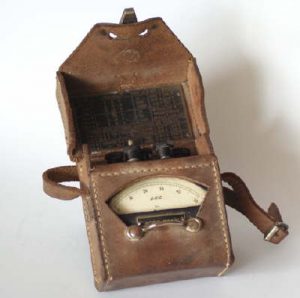
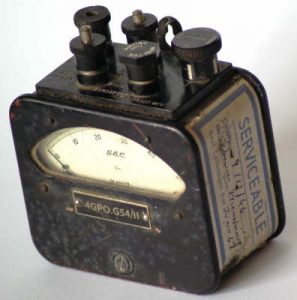
After leaving school (Greenhill Comprehensive, Tenby) in 1974 I went to Bristol university to study mathematics and physics. Looking back I can see that I was a pretty useless student. But I stuck it out with the aim of being a teacher. When the time came I thought it best to do something else for a few years before teaching.
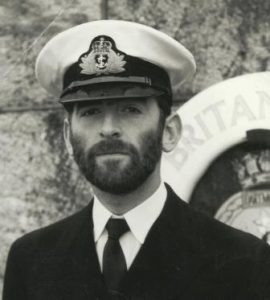 So I did something that my surprised my friends, I joined the Royal Navy (as an instructor officer). I have often said that joining the RN was one of the best decisions of my life, I went in as a snotty nosed 21 year old and came out a young man. Whilst this was not the best part of my life, I learnt a lot about myself in a very short period. The RN was a fantastic (but short) experience for which I have always been grateful. Today, more than 35 years later I still feel privileged to have been allowed to (temporarily) join Nelson’s “band of brothers”.
So I did something that my surprised my friends, I joined the Royal Navy (as an instructor officer). I have often said that joining the RN was one of the best decisions of my life, I went in as a snotty nosed 21 year old and came out a young man. Whilst this was not the best part of my life, I learnt a lot about myself in a very short period. The RN was a fantastic (but short) experience for which I have always been grateful. Today, more than 35 years later I still feel privileged to have been allowed to (temporarily) join Nelson’s “band of brothers”.
On leaving Her Majesty’s stone ship in Rosyth I managed to get a Science Research Council grant to study telecommunications on a M.Sc. at the University of Aston in Birmingham. But the grant was only for 6 months and the M.Sc. consisted of 6 months academic study followed by a 6 month project.
I was surprised to find out that telecommunications was all about telephone networks. At first it was a little bit strange since I was the first person in the course’s 14 year history that was not sponsored by their employer. All of the other attendees were sent by one or other of the telecommunications companies of the day: BT, GEC, Plessey, STC,…
However I learnt about telephony, I became familiar with names and technologies such as: Alexander Graham Bell, Almon B. Strowger and his Strowger switched telephone exchanges, crossbar exchanges, reed-relay exchanges, electronic switches, even Stored Program Control switches.
Although my father was born and raised in Birmingham (Digberth Street near the Bull Ring) I did not stay with our Birmingham relatives, rather I lodged in Alum Rock and took the bus to the university (I think it was an No. 14). One day, sitting on the bus, it was a cold and wet winters day and I was wearing a brilliant almost Day-Glo red thick down-jacket that made me look like a weird Michelin man, when it finally dawned on me that I was no longer in the RN and that I could relax, there was no senior officer watching me, I could laugh again. I had not realized until then just now much the RN had affected me.
Two of the guest lecturers on the telecommunications course are lodged in my memory:
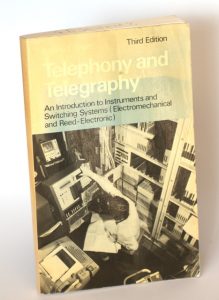
- Sid Smith His book is still on my shelf.
- Sam Welch He simply mesmerized me. I think that he was in his 80’s when I meet him. Nobody, but nobody, has ever affected me as much as Sam. Enthusiasm, character, charisma and a simple love of telecommunications.
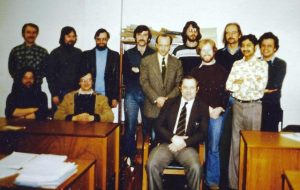 I am in the back row, fourth from the left, with a droopy mustache and my arms folded. Dr Ron Brewster the course leader sitting mid-front. A wonderful person who took pity on me as a “outsider” to telecommunications, and I was the same age as his son.
I am in the back row, fourth from the left, with a droopy mustache and my arms folded. Dr Ron Brewster the course leader sitting mid-front. A wonderful person who took pity on me as a “outsider” to telecommunications, and I was the same age as his son.
When the time came for the project the course leader (Dr Ron Brewster) obtained a industrial sponsorship for me to do a M.Sc. project. Sadly less than 4 weeks later that sponsor withdraw all of its university sponsorships in the UK and I was left with no choice but to abandon my M.Sc hopes and get a job. At this point (1979) I was head hunted by Plessey and ended up within 6 weeks at Edge Lane, Liverpool as a System-X hardware design engineer.
System-X was a BT project that was supported by three telecommunications manufacturers, to create a digital telephone network based on ISDN concepts:
- GEC (as it was then called) GEC had little experience with Stored Program Control systems, so they were given the SPC to develop. It had a lovely name POPUS (Post Office Processor Utility Subsystem). A processing system based on bit-slice technology, with virtual memory capability and programmed in a language called CHILL.
- Plessey- Plessey already had a successful Stored Program Control system used in their battle field digital command and control solution called Ptarmigan, so they were given the digital switching and the signalling interworking subsystems.
- STC- STC were given the message transmission and the maintenance control subsystems
There was a “closed-shop” agreement at Edge Lane that meant that I had to join the appropriate trade union within 6 weeks. On my second Tuesday in the company my department boss (Peter Hampson) came up to my desk and asked if I would walk with him. The office was a large open plan space with 200+ staff with a minimum number of low divider panels. Peter and I moved towards the “corridor” between some of the desks and then Peter asked if I had joined the union yet. I said that I had not. Peter went quiet, then he said that it was his strong recommendation that I go (immediately) to the union representative and join now. Two hours later there was a management lock-out and all the union members were “on-strike”.
It lasted six weeks, which was a pain since I had no income, except for a few pounds from the union strike fund. Still I did get to “man the picket line” and once I took part in turning a delivery lorry around and sent it back to Northern Ireland.
When I eventually got around to working at Edge Lane I found out that there were a small number of experienced engineers (telephony) but they had no micro-processor skills. The majority of the engineers were fresh out of university, understood a bit about processors but nothing about telephony.
I was in the curious position of having done the telecommunications course at Aston (a highly respected course by the industry) and at the same time I was not lost in computing. So Peter Hampson made me responsible for graduate recruiting and training in his department.
I was relatively free to poke my nose where ever I wanted. So I asked questions (about telephony, System-X,..), basically I said to people “I’ve got time, tell me what you are doing and why?”. This freedom was helpful since I had to create and give a training program lasting 13 weeks for new graduate entry engineers, and I just had to fill the timetable with as much telephone history and concepts as I could. This was a brilliant follow-up to the Aston course.
Since I had no direct design work Peter Hampson gave me ad-hoc jobs. The University Of Strathclyde in Glasgow was running a M.Sc. in teletraffic engineering and wanted a guest lecturer, so Peter nominated me, this happened 3 years in a row. Edge Lane was interested in modifying the Monarch PBX, so Peter put me on the review team. BT wanted to sharpen up the micro-processor engineering concepts across the project, so Peter put me on the team.
This was simply brilliant, I was getting exposure to a broad range of telecommunications topics.
Whilst the other engineers had their specific jobs (such as developing a digital system to interface to the classical MF2 signaling system, developing a card to interface to a “Long Distance DC” telephone trunk, developing an Automatic Break/Test Access unit), I was free to be nosey. So I had exposure to all of the design areas, whereas the true designers were lucky to work on 2 different units in 3 years.
After 4 years of this I moved to a small team lead by Joe Watts. We were to develop an alarm monitor and display system. Joe and the others would design the hardware and I would write the code for the two micro-processor systems. Two i8085 processors talking to each other via a FIFO. Human interface via a DEC VT 241 colour terminal. The system had RS232 interfaces to the alarm reporting interface of 32 System-X exchanges. Each interface generated about 32 bytes at, I think, 300 baud. This unit was part of a larger Operational Maintenance Center contract that Plessey had won.
Plessey had acquired the public switching part of Stromberg-Carlson in the United States. BT has agreed to purchase 6 OMCs from Plessey/Stromberg-Carlson and 6 from BT’s own research lab. After I had finished my coding project I was asked to be the assistant project leader to the Plessey Liverpool team who had to make the Stromberg-Carlson “off-the-shelf” OMC system fit for BT. That project was about 18 months old and had stalled. The development team, mainly software contractors were of the fixed opinion that the equipment specified by Stromberg-Carlson was not suitable (i.e. not powerful enough, it consisted of a pair of PDP-11 machines). I studied the situation, spoke to everyone, went back to our senior management and pleaded for serious help!
I was told that I was only 28, that this was my first big task, and it could not be so bad otherwise the project leader would have said. But the project leader (John) told me that he had always said that the system was underpowered, but no-one would listen to him.
Within 8 weeks of this non-stop stress my stomach started to feel heavy and hot, every second of the day. My doctor said it was easy, get a new job or get an ulcer.
I immediately started looking for a job, and spotted an advert in a computer magazine, I think it was Computer Weekly. Basically the advert was “Wanted: telecommunications software consultants. Stuttgart. German not needed. Hourly paid.” I flew out to Stuttgart for a job interview with a lad who was one of my project’s software consultants (Ian Rose if I remember correctly). We both had interviews that day with SEL in Zuffenhausen, Stuttgart. I am not sure who interviewed Ian but I have the vague recollection that it might have been Piet Oosterhaven team leader of MPTMON development (a System-12 proprietary test tool). I was interviewed by Karl Rothenhöfer head of System-12 special networks development. Ian declined the opportunity, but I had “no stomach” for Liverpool. So I went back to Liverpool and handled in my 4 weeks notice.
The joke of the situation was that BT had asked us (Plessey Liverpool OMC team) to attend a 3 day conference in Birmingham at which all of the key BT OMC people were to be present. During the 3 days there were a few 30 minute slots in which we (and in another room BT’s own OMC developers) were to demonstrate / present our OMC systems. Because of my shy retiring nature I was asked to be the Plessey lead presenter (okay I am not so shy or retiring). I argued with my bosses against this since the conference was Tuesday, Wednesday and Thursday of my last week with Plessey.
So I and a team went to Birmingham. I did everything I could to “sell” our system. I can still remember the face of Joe Watts standing in the back of the room when a BT guy asked if I could demo a specific OMC activity. I knew that we could not. So I played a dirty game. John the project leader was standing next to Joe. I shouted out across the room to John, something along the lines of “hey John, did we bring the X&Y modules”. Then before John could answer (not that he could because he was hiding his face in his hands in horror) I shouted out “no, no, sorry John I forgot that we had decided not to bring them” then I said to the BT guy “not to worry since the activities he asked for where in section -n- of the project compliance statement and our project offer stated clearly that we were fully compliant to that section”. Joe found it hilarious, John never said a thing.
On Friday I got a bit drunk at my lunch time “leaving do” in the pub close to the Edge Lane site, near the United Biscuit factory. And that was that. I stayed in Liverpool for about 10 more days to attend my best friend Nick Trickett-Bell’s wedding (Nick the rhythm guitarist). Then I was off to telecommunication activities in Stuttgart, Germany.
Funnily enough, Dylan, the drummer of our little music group also left Plessey, and where did I meet up with him again. Yeah, Stuttgart. and then we worked together again in Den Haag in 1992 also for Alcatel.
Oh yes, the really funny part was that within a month of me leaving Plessey the OMC project was stopped. And my “ulcer”, well, my stomach settled down after about 6 weeks in Stuttgart.